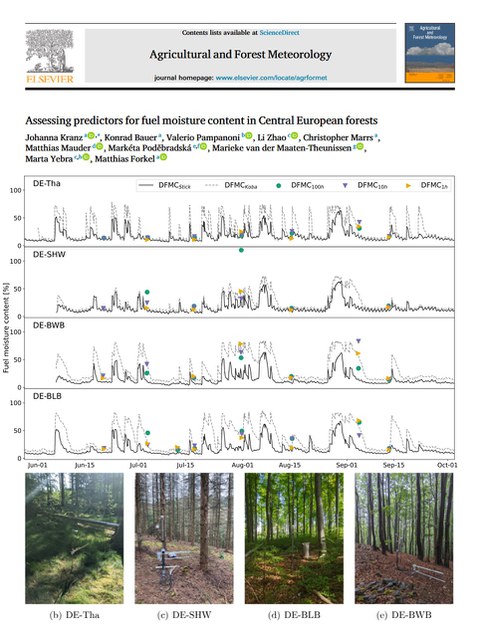Jun 02, 2025
New Publication: Assessing predictors for fuel moisture content in Central European forests
The moisture content of litter, woody debris and living vegetation controls the ignition and spread of fires and the composition of fire emissions. Since many forests in Central Europe were not previously considered fire-prone, very few observations and knowledge about fuel moisture content (FMC) are available.
In a new publication, we evaluated the representativeness of (i) continuous FMC measurements from in situ fuel sticks, (ii) a model of litter fuel moisture (Koba model) and (iii) a vapour pressure deficit based model for FMC of litter and woody debris across four temperate forest sites in Saxony at the Tharandt Forest and the Saxon-Switzerland National Park.
At these sites, we investigated the potential of fire weather indices from in situ meteorological or large-scale models and satellite products as predictors for live and dead FMC in a correlation analysis and using univariate generalised additive models (GAM).
Our results suggest that continuous 10-hour fuel stick measurements are predominantly in agreement with litter FMC in coniferous and deciduous stands. The Koba model shows a very high correlation with dead-FMC. Among the components of the fire weather index, the fine fuel moisture code emerged as the best predictor of fuel stick measurements (GAM performance: R=0.87, RMSE=4.1%), reflecting the expected relationship to destructively measured in situ FMC of litter and fine woody debris. FMC of live fuels is not or only weakly correlated with meteorological variables but moderate correlation was achieved with live-FMC retrievals from the Sentinel-1 radar satellite. The fire weather index from the European Forest Fire Information System (EFFIS) underestimates the variability of locally measured fire weather and FMC.
The publication contributes to Johanna Kranz’s PhD research and is an outcome of the DAAD travel project “2I-Fuel”, which focuses on the intercomparsion of different methods and datasets of live and dead fuel moisture content. During research visits at TUD and the Australian National University (ANU) in Canberra, knowledge and data were exchanged. In addition, as a part of the DAAD project, PhD student Daniel Kinalczyk travelled to ANU to analyse trends in ground LFMC measurements from the GlobeLFMC database by ANU professor Marta Yebra. During a field visit, he tested the Wiltronics Fine Fuel Moisture Meter, which facilitates the acquisition of validation data for FMC.
Publication:
Kranz, J., Bauer, K., Pampanoni, V., Zhao, L., Marrs, C., Mauder, M., Poděbradská, M., van der Maaten-Theunissen, M., Yebra, M., and Forkel, M. (2025).
Assessing predictors for fuel moisture content in Central European forests.
Agricultural and Forest Meteorology, 371, 110590, https://doi.org/10.1016/j.agrformet.2025.110590
Dataset: Kranz, J., Bauer, K., Pampanoni, V., Zhao, L., Marrs, C., Mauder, M., Poděbradská, M., van der Maaten-Theunissen, M., Yebra, M., Forkel, M., 2024. Sensitivity of fire weather indices, fuel sticks and satellite observations to fuel moisture content in Central European forests - Data. https://doi.org/10.5281/zenodo.12732295

